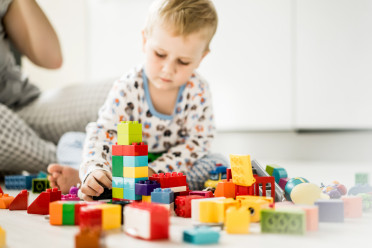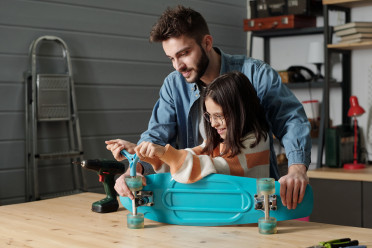
Paper Airplane Races
Design and build your own paper airplanes, then have a race to see which stays in the air the longest or flies the furthest. Have each contestant race one plane or have one child make several using different patterns, then measure which is the most successful — and figure out together why that plane flew the farthest.
Here are some online videos that provide instructions for making basic planes:
Level Up:
For older kids who want a more competitive design or who like conducting research, spend some time online or check out library books on the topic to learn about aerodynamics and the science behind flight time and distance. Then, challenge them to create their own design!
Conversation Sparks
Why do you think the winning plane went the farthest (or stayed the longest in the air)? What will you do differently the next time you make paper airplanes to make them fly farther?

Let’s Go Fly a Kite!
Learn about how kites fly and then go fly them. Make sure you choose the right day for this activity. Most kites fly best when there is mild to moderate wind (8 to 24 mph).
Level Up:
Build your own kites out of different materials and see which fly best. Here are a few websites you can use to help you explain the physics behind kite flying and learn to make a kite:
Conversation Sparks
Why do you think the kite stayed up so long in the air today? Why do you think it crashed?

How Tall Can We Build?
Assemble a set of blocks or other household objects you can stack and see how high you can build your structure (books, shoeboxes, plastic containers, plastic cups or so forth). See if you can build a structure taller than your kid!
Level Up:
Before getting started, guess how tall you can make the structure before it will fall down. Then, build your structure, measure it throughout the process using a tape measure, and see if it falls before or after it reaches the height you guessed. You can make this a game by seeing who makes the best guess on final height. Here’s an article by Scientific American that takes this idea a step further for older students.
Conversation Sparks
Which is more stable and resistant to falling — a pyramid or a tall skinny building? Why do you think that’s the case?

Cooking Capers
Using a cookbook or website, pick a recipe for a meal or baked item the child would like to learn to make with you, then use this opportunity to teach age-appropriate cooking basics and kitchen safety. If your child is older or experienced in the kitchen, challenge them to make it by themselves with you supervising.
Level Up:
Plan the ingredients you need to make the item, go to the grocery store and use basic addition while you shop to see if your child can estimate the total cost of the ingredients before you visit the cashier.
Conversation Sparks
If you were a chef, your job would be to come up with new foods for your restaurant’s menu and make them taste good enough to please your customers and make them want to come back. What do you think could be added or subtracted from the recipe you made to make it taste even better?

Design and Build Something
Using drawing supplies, sketch out designs for a building, machine, clothing item or something else you child wants to make. Then, use other household items (cardboard, scrap fabric, recycled containers, shoe boxes, toilet paper rolls, etc.) to build it.
Level Up:
Create a museum of your creations and invite friends, neighbors or family to come to the exhibit. Make posters to promote the event and make refreshments to serve to your visitors!
Conversation Sparks
Create a museum of your creations and invite friends, neighbors or family to come to the exhibit. Make posters to promote the event and make refreshments to serve to your visitors!

Investigate Plants
Go outside and see how many types of plants you can find and either collect a cutting of their leaves or take a photo of them. This activity could be done in your backyard, at a park or on a hike. Remember to bring a bucket if you are collecting live specimens — and even a magnifying glass to get a closer look. (Watch out for poison ivy and other troublesome plants!)
Level Up:
Bring your specimens home and see if you can identify each species using online resources or a book of local plants and wildflowers. Make it a game with several kids to see who can find the most different species of plants. This blog provides questions you can use to help identify the species of plant.
Conversation Sparks
If you were an animal looking for food to eat, which of these plants would be the most appetizing? Which might look dangerous to eat?
Go on a Household Item Scavenger Hunt
This is a great activity for early childhood exploration of the world around us. Choose a color and count how many items in your house the child can find with that color. Make it a game for multiple participants by seeing who can find the most items with the color — and only allow one person to use each item.
Level Up:
Challenge the child to look for tools or other items in your house, garage or toolshed used in a specific job or trade. For example, look for items in your house that a painter uses in their job. Or a librarian, construction worker, tailor, baker, landscaper or nurse. Again, make it a game by seeing who can find the most items for a specific job.
Conversation Sparks
What would the worker use this tool for in their job? What tools in our ____ (kitchen, garage, basement, attic, bathroom) would someone who works at a _____ (restaurant, service station, store, office, salon) use in their job?

Watch a Cool Careers Video
HirePaths’ five-minute videos each explore a high-demand career your child could someday consider. Watch one video at time, or watch them all in one setting and then have a short conversation about which you liked best and why.
Level Up:
After you watch a Cool Careers video, think of someone with a similar job the child might be interested in they could interview themselves. You could even make your own video of the experience on an iPad or phone. If you make one, please send it to HirePaths! We’d love to see it. Email your child’s videos to [email protected], and we’ll send a response praising them for their efforts. We might even offer to share it on our social media channels!
Conversation Sparks
Had you heard about this career before? What surprised you the most? What do you think you’d like — or not like — about having this job?

Plant a Garden
Start (or work in) your home garden (you can even add a roleplaying element and pretend to be farmers!). Do this in your yard, in pots, a raised bed, or even indoors. Pick out seeds or seedlings to plant, prepare the ground, plant according to the directions, water as needed, then harvest the crop when it’s ready. Make sure to allow for adequate light for the plants you’re growing. Here’s a handy site to help you get started.
Level Up:
Create a daily log to track the process. You could even take pictures to enhance the log and record changes. Ask your kids questions such as:
- How many days did it take the seeds to sprout?
- How much taller did the plants grow each day?
- How many flowers or fruits did the plant sprout that day?
- What insects are you seeing in the garden?
If you have a fruitful harvest, put together a stand at the end and sell your produce to neighbors! (Then you can practice your skills from the Money Mania activity!)
Conversation Sparks
How many days do you think it will take before the seeds sprout? How much did the plants grow each day or week? How many fruits do you think this plant will produce by the end of the summer?

Have a Lemonade Stand
This classic first entrepreneurial adventure can be set up to sell just about anything your child can help make — drinks or popsicles on a hot day, baked goods, harvested vegetables from your garden, or craft items. Here are some tips for preparing your stand and the products you’re going to sell:
- Find a good location that’s safe from traffic but still visible to those driving or walking by. Decide whether the children are safe there alone or if they need an adult to supervise at all times.
- Find a table, chairs and other supplies for your stand.
- Prepare the items to sell and decide how much to charge for each.
- Have change and a way to safely store the money.
- Talk about the concept of profit being the difference between your costs and the money you make. Decide what to do with the profits: Will the kids keep them for themselves or donate them to a charity?
Level Up:
Advertise your lemonade stand to your neighbors the day before so they’re ready to come! Make posters, send emails, make phone calls, post in your neighborhood group, send texts or whatever it takes to advertise the stand to friends, neighbors and families so your kids get a crowd of real customers to wait on.
Conversation Sparks
What was your favorite part of having a stand? What products sold the best? What did customers say about your products? What could you do to make the stand better next time?
Cash in Spare Coins
See how much spare change you can find in your house (check car consoles, between couch cushions, junk drawers, laundry rooms and other places people lose or put loose coins). Once you’ve exhausted your search, add up how much money you and your child found (another great opportunity to teach the value of different forms of currency, see Money Mania), and talk about what you could buy with that money. Then, maybe use it to buy something fun or donate it to a favorite charity.
Level Up:
If you find a lot of money, take the money to the bank or store and have it converted into larger bills or deposit it into a savings account. See if the bank has a changing machine and if they’ll let your kid dump the coins in themselves.
Conversation Sparks
What can we buy with this much money? Who might benefit from this money more than us? How could we help other people with this money? Why might we want to save this money for your future?
Learn Computer Basics
Kids are whizzes at computing, but sometimes we adults forget to teach them the basics and assume they are just born with skills like:
- How to plug, unplug or charge a computer (or other electronic device like a phone or iPad) safely
- How to turn on and off a computer appropriately
- How to save a file and open/close it to use another time
- How to put a file in the trash and destroy it
- How to do basic formatting in a word processing program (fonts, colors, styling of lettering, tabs, inserting photos, drawing boxes or circles, etc.)
- How to type (lots of programs available to teach this valuable skill)
- How to print a document
- How to change the ink or add paper to a printer
- How to save a file to a jump drive (and how to correctly eject the drive)
Level Up:
Ask your child to teach YOU or a younger child to do some of these basic things as a way to test if they really know how to do it themselves!
Conversation Sparks
What did you learn today you hadn’t been taught to do before? How could you use these skills at school or in a job someday?
Learn About Energy
Everything in our world is powered by a type of energy (electric, hydro, wind, gasoline, kinetic, gravitational, nuclear), but many kids never think about how that energy is generated and moved from the source to their home. Watch some videos and do activities to see energy in action. Here are some at-home energy activities that could keep your kids busy for weeks:
Level Up:
The Kansas Energy Program has an assortment of free resources, games and puzzles that teachers or parents can use at home or in classrooms to learn about energy.
Conversation Sparks
What did you learn from this activity about how electricity works? What’s the most dangerous part of working with power? What jobs have you heard of that involve moving energy from one place to another?

Learn to Code
Learning the basics of computer programming is a valuable skill, and like learning any language, learning how to “speak” in code is easier the younger you start. If you’re like many adults, if you try to learn alongside your child, they may pick it up quicker than you do. The nice thing about coding is you can do it almost anywhere — on a home desktop computer, tablet or even a phone. There are many software programs to teach kids how to program, even in preschool. Apps range in cost from free to inexpensive (we personally love Scratch, but there are many others):
Level Up:
A lot of kids dream of becoming a video game designer. Encourage kids to research how they’d go from basic coding to video game development and design. This video shows how to make your first game.
Conversation Sparks
What’s the hardest part of learning to code? What was the most fun? What was the easiest? What problem would you like to solve using a computer program?

Fix Something
We live in a disposable society, so many kids don’t automatically think about fixing something that’s broken. Next time something in your house needs a DIY repair job, involve your kid in the process of learning what you need to do, finding the tools and supplies you need, and then do the work to fix the problem – together.
Level Up:
If this is a repair job you aren’t quite sure how to handle yourself without some support, give your kid the key information they might need and see if they can find online instructions or a video that can help! If it seems like the repair is within their skill-level, see if they can follow the instructions to fix it themselves. This can be a very empowering process to do from start to finish for anyone, let alone a kid.
If you determine this repair is beyond your skill set or comfort level (such as wiring or plumbing), when a professional comes into your home, see if they’d be willing to let you and your child watch them work – and ask questions!
Conversation Sparks
Was that work harder or easier than you expected? If we couldn’t fix it ourselves, what kind of professional would we need to call to fix it for us? What types of jobs fix things?
Read Real Success Stories
Kids can’t aspire to a job if they haven’t heard of it in the first place. HirePaths has created a library of stories of professionals living in Kansas or the Midwest. Explore these stories by industry area or randomly. Together, find stories to read and discuss, or you can review them and send stories to your child they might find interesting via text or email.
Level Up:
Use our scavenger hunt or BINGO worksheets to encourage kids to spend more time on the site — or challenge a few kids to see who can find the answers first. (Prizes are always motivating, too!)
Conversation Sparks
After reading some of the stories, did any of these jobs seem exciting to you? Which jobs don’t interest you, and why?
Play Eye Spy for Jobs!
Sit down to watch one of your favorite TV episodes or movies and see how many jobs your family can find! Shout out every time you see a different job represented. This could also be done when reading a book together.
Level Up:
Turn this into a game by having the kids silently write down the jobs they see (or text them to you on their device), to see which kid can find the most jobs. Or, see if they can find more jobs in the program than you do! Then, use HirePaths.com or other online resources to learn more about the most interesting careers.
Conversation Sparks
Which job did you see in the show that you’d like to learn more about? Do we know anyone who has that job?

Write a Story About Your Future Career
Challenge your child to write a story about what they think their life will be like in 10 (or 20) years when they’re done with school and have their own job.
Level Up:
Illustrations can bring even the simplest stories to life! Keep the book and give it to the child someday as a graduation gift.
Conversation Sparks
What kind of place do you think you’ll want to work in? Will you live in our town or somewhere else? What type of clothes will you wear for work? What kind of tools will you use? Who will you help in your job?
Start a Business
What can your child make (with or without your help) that people might want to buy? This can be adapted for their interests. Can they:
- Build birdhouses?
- Bake bread or cookies?
- Make jewelry?
- Water plants?
- Walk dogs?
- Mow the yard or pull weeds?
- Babysit for younger siblings, neighbors or friends?
Work with your child to identify something they are good at and like to do that people might be willing to buy or pay money for them to do. Then, come up with a name for their business, a list of people they could sell their products or services to, and advertise!
Level Up:
Help your child make a Facebook page, website or online store to promote their business. Share it with your friends. Or, create fliers to distribute throughout the neighborhood.
Conversation Sparks
How much time do you think it will take you to do the job (or make the product)? How much money do you think people would be willing to pay for this job (or product)? What are you going to do with the money after you make it?

Build Something
Brainstorm something you and your child could build together — or research a few options and let the child choose. This could be something useful you need in your house, or something the kid has dreamed up. Together, create a plan, set up a budget, assemble or purchase the supplies or tools, and get to work.
Level Up:
Find a problem in your house and invent a solution you can build to solve it!
Conversation Sparks
What was your favorite part of building (the item)? What was the hardest part? What would you do differently next time? What types of jobs involve building things?
Plan a Party (or Project)
Thinking through a project or event is a skill even many adults aren’t very practiced at. If you’re planning an event (like a birthday party) or to do something around the house (like redecorate their bedroom), sit down with your child and work on a plan together. When should you do the event or project? What will you need? Who else will participate?
Level Up:
Add lessons about budgeting for your party or project. Think through all of the steps required to make the project happen and what you might need to buy to achieve the goal. Set a budget and see if they can create a plan using a combination of items you already have or items you’ll agree to buy within that budget. Then, work with your child to do the project or host the event and see if you can actually do it within the budget.
Conversation Sparks
What was your original vision for the event or project? What went according to plan? What did you have to change to stay within your budget? What types of jobs do a lot of planning and budgeting?
Do a Career YouTube Challenge
Go to YouTube and type in, “What’s it like to be a [insert career name]?” Watch each video and talk about the pros and cons you learned about the profession. We recommend you do this activity with your child to make sure you don’t end up on a video that’s not age-appropriate.
Level Up:
Choose someone you know who is in a specific profession and interview them about what it’s like to do their job. Make a video of the interview and share it with friends. If you got the subject’s permission, you could even start your own YouTube channel and share your video with the world. (If you make a video, we’d love to see what you made! Send a link to [email protected].)
Conversation Sparks
Did the video answer your questions about this field? What type of training do you think would be best if you were interested in pursuing this type of work? What skills that you’re learning in school now would be helpful in this job?
Take Career Quizzes
There are many free and low-cost online tools you can use to assess a child’s strengths, interests and aptitudes to see what types of jobs they might be a good match for someday. Some of these even compare your innate skills with the level of education you’re interested in pursuing. Check out these HirePath’s blogs for several you could try with your child:
There are many other online tools you could use. It’s fun to see if different tools have similar or different recommendations. Here are a few others to check out:
- CareerOneStop Work Values Matcher
- CareerOneStop Skills Matcher
- O*NET Ability Profiler
- O*NET Work Importance Locator
- State Library of Kansas Interests Matcher and Skills Matcher and “Find a Career Match” page for high school students
- 16Personalities
- ASVAB Career Exploration Program (Armed Services Vocational Aptitude Battery; Department of Defense)
- The ASVAB Career Exploration Guide, Find Your Interests Quiz
Level Up:
Once you’ve completed a quiz or assessment, research the jobs the program recommends on HirePaths.com or other online career exploration resources.
Conversation Sparks
How much more education do you think you’ll be interested in after high school? What job did the program suggest that seems like a crazy match for you and why? What jobs that the program suggested are worth investigating further?

Clean Something
Similar to Build Something or Start a Business, Clean Something can be about teaching your child how to do everyday household chores that are good life skills for anyone to have — but these skills can also translate into entrepreneurial endeavors. By the time they reach kindergarten, most kids are old enough to help with laundry, vacuuming, cleaning a car inside and out, washing windows, sweeping the porch, loading the dishwasher, handwashing dishes and so forth. Working alongside you can also teach them a good work ethic and to approach work with a positive attitude.
Level Up:
Have your child teach a younger sibling how to do household chores. Or, help your child start a cleaning business and advertise your child’s services to friends, neighbors, or family members.
Conversation Sparks
What types of jobs do this task? In what types of settings do people get paid to do this type of work? Do you think you’d like a job doing this type of work someday?
Invent Something
Choose a problem in your house and then challenge your child to invent a way to solve it using household items.
Level Up:
If you’ve never built a Rube Goldberg Machine, here’s something your kids will love to do with you — again and again. There are many online videos to help you get started, but here are a few resources that will help:
Conversation Sparks
What worked according to plan? What part of the idea failed? How could you improve upon the invention?
Play Career Charades
Have each player write the names of different jobs and careers on slips of paper (use the HirePaths Explore Careers section for ideas). Put the slips into a jar or box and take turns drawing out jobs to act out. Set a time limit (like one minute per turn) to keep the game moving.
Level Up:
Keep an iPad or computer nearby, and if the child isn’t familiar with the job they draw, allow them research it — or allow the child to redraw. Once the game is over, choose jobs that the kids didn’t know and look them up to learn more about what people in that job do, where they work, and what kind of training they need to get started.
Conversation Sparks
What job had you’d never heard of before? What job was hard to act out and why? What job did someone else act out that might seem interesting to you?
Learn About Supply Chain and Deliveries
United States Postal Service employees and other types of delivery drivers come to our houses nearly every day. While these busy workers are usually on a tight schedule, if you can time it right, they’ll stop and chat with you and your child for a minute or two about what they like best about their job and how they got started.
Level Up:
Follow an online order from your virtual shopping cart to your front door:
- Choose an item to order online.
- Order it and see what your shipping options are. Discuss the various methods of the item getting to your house, what each one costs and how long each will take.
- After you place your order, use the tracking information each day (or morning and night) to follow your item on its journey.
- Watch for the delivery the day it is supposed to arrive. In some cases, you’ll even get a text telling you the item has come.
- Talk about the different types of vehicles that might have been used — cargo ship, semitruck, airplane, delivery truck, forklift — to get it from the warehouse to your front door.
Conversation Sparks
How many days do you predict it will take to get to our house? What types of vehicles do you think the item was carried in as it traveled to our home? How could it have gotten to us more quickly, even if it would have cost more?

Get to Know Your Camera
In this activity developed by Kansas 4-H Youth Development, kids will learn all about cameras and how to use basic features like zoom.
Level Up:
Alternate between landscape and portrait mode to see what better frames your photo.
Conversation Sparks
What differences did you see between your first photo and others after that?
Horticulture: Pollinator Garden
In this activity developed by Kansas 4-H Youth Development, kids will learn about gardens, flowers and insects.
Level Up:
Research which plants you would like to use, consider your location, then design your own pollinator garden.
Conversation Sparks
What was the most important thing you learned about planning a pollinator garden?
Quick Bread vs. Yeast Bread
In this activity developed by Kansas 4-H Youth Development, kids will make and evaluate three types of breads: muffins, biscuits and yeast breads. The guide includes bread baking tips, recipes and evaluation guides.
Level Up:
Share some of your bread with family, a neighbor or a friend.
Conversation Sparks
What was the hardest part of the activity?
Macramé
In this activity developed by Kansas 4-H Youth Development, kids will learn common macramé knots and how to incorporate principles of design into developing their own items. The guide also includes directions for making friendship bracelets.
Level Up:
Use two or more colors to create a design.
Conversation Sparks
Which knot was the hardest for you to learn?
